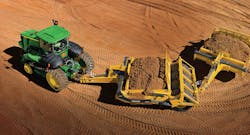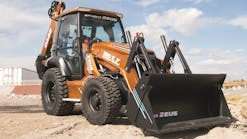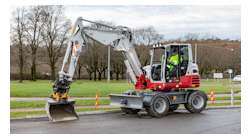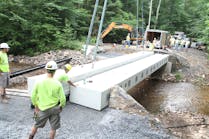New doesn’t last forever. When the newness wears off of heavy equipment—or when a diesel engine reaches 6,000–10,000 hours—it’s time to make a decision: purchase another new machine or repair, recondition, rebuild, or remanufacture the now not-so-new one. In order to make the best choice, several factors must be considered.
First, it’s important to understand the customer’s business, advises Jim Cole, vice president of vocational sales and product integration at Omnitek Engineering Corp. His questions for fleet managers to help them decide if reman is right for them include finding out the duty cycle and time cycle and determining the number of miles driven per year. “You need to know the drivability parameters,” he says, adding, “If you keep it less than five years, don’t reman.”
Reman “always makes sense for smaller components” including the alternator, starter, hydraulic fuel pump, and injectors, claims Kurt Coffey, director of sales and marketing for CNH Reman. Even on larger capital items such as engines and transmissions, he believes it makes sense most of the time.
However, when choosing between repair and reman, he advises evaluating on a case-by-case basis. “If you have a nuisance problem or a catastrophic problem or failure with a high-dollar engine on a machine you use all the time, reman makes sense,” observes Coffey, “because it saves thousands.”
The process of elimination in diagnosing the problem can become cost-prohibitive, so it can save money to go directly to a reman option. “Spending a lot of time on diagnostics is expensive,” states Coffey. “If you can fix the problem at less than 75% of the cost of reman, just fix it, but if it’s a catastrophic problem, you’ll need a full reman.”
Opting for a reman in response to a catastrophic failure, particularly midway through construction season, can improve customer satisfaction. “People like the extra warranty and less cost,” says Coffey. “If you have to rebuild a new vehicle, the customer is unhappy. It’s better to replace income-producing newer machines with new or reman.”
Conversely, he says if it’s a backup machine or an older machine, just fix it. “Don’t throw tons of money at older machines,” advises Coffey, although he admits that some of the top-selling parts go on machines from the 1970s.
Distinguishing the Differences
For years, reman carried the stigma of used parts. It’s an arduous task to overcome that reputation, but Coffey says the industry is carefully choosing descriptive language to make distinctions. “It’s not rebuild, reuse, or refurbish; those words carry a stigma. It’s reborn.”
Remanufacturing takes a worn or non-functional component and returns it to a “like-new” or “better-than-new” condition, and is covered by a warranty to ensure like-new levels of performance and quality, explains Mark Wagner, reman product marketing manager with John Deere Construction & Forestry. He defines three repair solutions in order to point out divergences.
The cleaning stage of a John Deere reman
Remanufacturing:
- Complete disassembly of the component
- Replacement of all wear components (like bearings and seals)
- Replacement of all failed components
- Testing to new performance specifications
- Warranty covering defects in materials and workmanship
Reconditioning:
- Limited disassembly
- Replacement of some wear components
- Replacement of failed components
- Limited performance testing
- May or may not carry a warranty
Repair:
- Disassembly to the point of failure
- Only failed component is replaced with new or used parts
- May or may not carry a warranty
All John Deere reman components are remanufactured, not reconditioned or repaired, elaborates Wagner, in order to meet or exceed new performance specifications. “As a result, customers can expect the same level of performance and durability in a remanufactured part as they can from a new component.”
John Deere Reman also incorporates the latest design updates and enhancements into the product to ensure the customer benefits from the design changes.
Reman is not a band-aid, continues Coffey. It is a premium solution. “The final product is as good as new due to tight quality testing on every part.
He explains the process: the engine is disassembled to the bare core and cleaned. All mandatory replacement wear parts are replaced and tested before the engine is reassembled to OEM spec.
Coffey contends that reman employs more rigorous testing than new in some cases. For example, in addition to running an engine on the dyno, he says testing includes using air to check for leakage because air is more viscous. “Parts go down to the bare core and are reassembled back to spec on an assembly line. It’s almost like new.”
While a reman produces a like-new product, a rebuild or refurbish only replaces the problem components. “They repair to the point of failure,” explains Coffey.
Guaranteed Benefits
Although reman provides a like-new machine, it typically costs 20–40% less than new with comparable parts. “John Deere Reman components can be up to 40% below the price of new, so the customer gets the same level of performance and durability as new at a significantly reduced cost,” expounds Wagner.
Another example of the decreased cost of ownership provided by reman comes in the form up uptime versus other repair options. A typical reman on a skid-steer loader is a 10- to 14-hour job, as opposed to 40–60 hours for an overhaul, estimates Coffey. “Opportunity cost is more than price.”
Another key advantage of reman is a warranty that’s often better than new. Wagner says that John Deere Reman components come standard with a premium one-year unlimited hour warranty (parts and labor, when dealer-installed).
Coffey says that an engine warranty from CNH is equal to new (two-year warranty on parts and labor) and for other parts, is better than new: 12 months (versus six months for new). In contrast, an overhaul done by a dealer doesn’t usually come with a warranty as comprehensive. “They buy a kit, send the head out, and reassemble the parts from a kit,” he says. “The dealer can’t warrant the work of others, so you may not be covered for issues. When one overhaul goes wrong, the dealer realizes how valuable reman is; it’s betterthan an overhaul.”
He says reman warranties are better in order to take objections off the table. “It’s like when Kia and Honda offered 10-year warranties. They believed in the quality and wanted to remove objections to encourage people to take a chance.”
Further objections were removed due to extensive testing and tooling, notes Coffey. “We test every part to measure quality and ensure it’s equal to or better than new.” CNH’s benchmark is a comparison with new parts.
Another important benefit is reduction of downtime, a contractor’s nightmare. Coffey points out that dealers and contractors both profit from reman because a dealer can remanufacture three engines in the time it takes to overhaul one.
In addition, remanufactured components provide value to the customer through mitigation of repair risks, providing more uptime. John Deere Reman utilizes an exchange program to provide remanufactured components, which are stocked in the parts distribution system. “This minimizes downtime to the customer because when a component failure occurs, the dealer is able to order a replacement component ‘off-the-shelf’ and simply swap out the failed one,” explains Wagner. This gets the machine back up and running in the shortest amount of time possible. The dealer then returns the original (failed) component to the factory as a core to be remanufactured and put back on the shelf.
A remanufactured 310 back at work
Repower: a Different Kind of Reman
Considered the backbone of the transportation and construction industries, diesel engines provide power, fuel economy, and durability. However, increasing fuel costs and stringent emissions regulations have convinced fleet managers to consider affordable options for transitioning to natural gas. Converting a diesel engine to a clean-burning natural gas engine that runs on compressed natural gas, liquid natural gas, or renewable natural gas (biogas), all at a fraction of the cost of a new natural gas vehicle, could extend the 20-year service life of the initial diesel investment for another seven to 10 years.
Repowering involves changing the power plant (engine). Omnitek remanufactures older heavy-duty diesel engines by converting them to EPA-approved spark-ignited natural gas engines. No one else does this in the heavy-duty market, says Cole. It’s patented technology.
The engine conversion steps are similar to those of an overhaul: disassemble the engine, clean and magnaflux, and replace. “We machine the head where diesel fuel injectors were to accept spark plugs,” explains Cole, “and change the compression of the engine from 18:1 to 10.5–11:1 for heat control and install natural gas components—pistons, rings, valves, ECU, wiring harness, lightweight three-way catalytic converter.” After installation, the engine is placed on a dyno for evaluation.
Popular engines Omnitek has converted include Cummins, Detroit Diesel, Caterpillar, and Navistar in the USA; Mercedes, Volvo, MAN, and Cummins in Europe; and Isuzu, Hino, Nissan, and Mitsubishi in Asia.
After conversion, the engine typically weighs 200 pounds less. Diesel is the best fuel for horsepower and torque, states Cole. Despite a 10% loss when an engine is converted to natural gas, he says there is no loss of performance. In fact, he says that although low-end torque is slightly reduced, Omnitek’s natural gas engines have a bigger payload than new natural gas engines.
The three-year warranty and five-year emissions warranty surpasses most reman warranties, but the real advantage of the conversion lies in reduced exhaust emissions. Producing virtually no particulate emissions, the natural gas Omnitek engine produces up to 20% less CO2 emissions, compared with diesel engines.
“Natural gas is 25 to 35% cleaner in greenhouse gas emissions than diesel,” adds Cole. The public relations aspect of running cleaner fuel is part of the “soft financials” benefits of the Class 8 heavy-duty diesel-to-natural-gas conversion. Sustainability is part of being a good corporate citizen.
For the hard dollar figures, Cole says the conversion is more expensive to do than a regular reman. However, fuel savings, maintenance savings, and a longer warranty often result in a return on investment of less than a year. In addition, the conversion is typically eligible for government incentives that offset the cost: funding, tax credits, or rebates for converting to alternative fuel.
With the cost of a reman at $20,000 or more, Cole says it’s the perfect time to see if a fleet manager is interested in a repower, especially if the duty cycle is greater than four years, the machine drives at least 100,000 miles per year, or if the engine is damaged. “The key to selling it is that it provides an option. The price of diesel versus natural gas is equal, but this extends the initial diesel investment.”
Since beginning the diesel-to-natural-gas conversions in 1998, Cole says Omnitek has done “about 5,000 overseas,” but few in North American because he says the process isn’t widely known. He predicts that it will become more popular when more fleet managers discover the alternative.
Reman Deman(d)
Omnitek faces stiff competition. According to CNH’s Coffey, demand for reman is “tremendous.” They’ve experienced 150 to 160% growth—and he says Cat and Deere are well ahead of them.
Market demand for remanufactured components is strong and continues to grow, agrees Wagner. “Customers see the value in utilizing remanufactured solutions because of the impact on their operations,” he speculates. “As technology and components get more complex, we will continue to see more pull from the market for additional remanufactured solutions.”
Lowering the total cost of ownership through remanufacturing creates market demand, believes Coffey. It’s one reason off-road has become one of CNH’s main focus points. “We realized in 2008 that if we’re not competitive in the after-market price structure, we could lose new sales.”
Some manufacturers fear the loss of new equipment sales if they offer reman, he says, but CNH sees it differently. If all the parts for a backhoe, for example, are “new and pricey, but your competitor has cheaper reman parts, you’ll lose sales. The market is always running; you’ll always sell new equipment. Offering reman extends the usable life of the equipment, and that attracts customers.” Besides, he notes, after two overhauls or remans, the rest of the machine is typically worn out and will need to be replaced.
Until it does, reman offers a viable option for extending the life of heavy equipment at an affordable cost, which explains its phenomenal growth rate. As it increasingly becomes part of the lexicon, Coffey believes reman “fundamentally changed the industry.”











